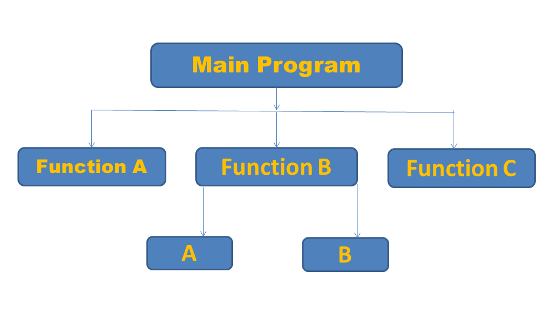Function in Python
Function is a set of statements which is used to perform various task.Function is more helpful when you have too much line of code then you can make a function for any specific task.

Advantage of function
- Function reduce the duplication of code.
- The length of source program can be reduced by using function at appropriate places. This factor is particularly critical with micro computer where memory space is limited.
- It is easy to locate and isolate a fault function are further investigate.
def keyword are used to define the function.
Synatx of creation and callingdef function_name(arguments): #statements #statements return arguments function_name(arguments)
Here function_name is the name of function it is start does't start with number or any special symbole like (! ,@ ,# ,$ ,^ ,&etc). In function we can pass zero or more arguments.return type may or may not be present.
Exampledef multi(a,b): c=a*b return c var=multi(6,5) print(var)Output
30Function with return value and with passing value
Python functions can return values, providing results for further computation or display. Passing values to functions allows for dynamic parameterization and tailored processing of data.
Example
#Here add is a function
def add(a,b):
return x+y
val=add(5,6)
print("sum=",val)
Output
sum=11Function with return value and without passing value
Functions in Python can return values, enabling the retrieval of computed results for further use. When not passing values, functions rely on predefined logic or external variables for processing.
Example
#Here add is a function
def add():
a=5
b=6
return x+y
val=add(5,6)
print("sum=",val)
Output
sum=11Function without return value and with passing value
Functions in Python can execute tasks without returning a value, streamlining procedural operations. Passing values to functions facilitates flexible and parameterized functionality within the program.
Example
#Here add is a function
def add(a,b):
val=a+b
print("sum=",val)
add(5,6)
Output
sum=11Function without return value and without passing value
A function without a return value doesn't provide any output after execution, and if no value is passed, it operates without any input data.
Example
#Here add is a function
def add():
a=5
b=6
val=a+b
print("sum=",val)
add()
Output
sum=11Function take default value
Functions can utilize default parameter values, allowing them to execute with predefined arguments when none are provided. This feature enhances flexibility and simplifies function calls by providing a default behavior.
Example
#Here add is a function
def add(a=5,b=6):
print("a=",a,"b=",b)
add()
Output
a=5 b=6Function take one default value one passed value
A function can take a default value if no value is passed, or it can use the passed value if one is provided.
Example
#Here add is a function
def add(a,b=6):
print("a=",a,"b=",b)
add(a=5)
Output
a=5 b=6
Explore comprehensive tutorials and practical examples of Python functions, essential for mastering efficient coding and problem-solving. These tutorials cover concepts like defining functions, returning values, and passing parameters, providing a thorough understanding of how functions streamline procedural operations and enhance code reusability. Dive into these tutorials to gain expertise in utilizing Python functions for dynamic behavior and tailored data processing, empowering you to write cleaner, more modular code.